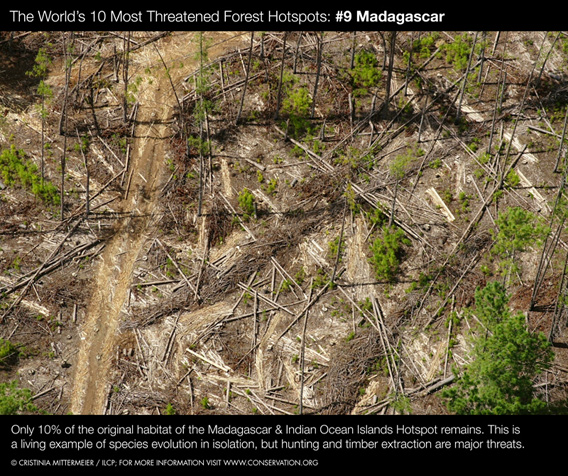
The press release from Conservation International originally listed New Zealand as possessing the world’s 2nd most threatened forests when in fact it is New Caledonia’s forests.
Asia-Pacific forests are the most endangered, including 5 of the top 10 threatened forests.
Growing populations, expanding agriculture, commodities such as palm oil and paper, logging, urban sprawl, mining, and other human impacts have pushed many of the world’s great forests to the brink. Yet scientists, environmentalists, and even some policymakers increasingly warn that forests are worth more standing than felled. They argue that by safeguarding vulnerable biodiversity, sequestering carbon, controlling erosion, and providing fresh water, forests provide services to humanity, not to mention the unquantifiable importance of having wild places in an increasingly human-modified world. Still, the decline of the world’s forests continues: the FAO estimating that around 10 million hectares of tropical forest are lost every year. Of course, some of these forests are more imperiled than others, and a new analysis by Conservation International (CI) has cataloged the world’s 10 most threatened forests.
The list catalogs forests that have already lost 90% of their original extent, but are still hotspots for biodiversity, represented by at least 1,500 recorded endemic species of plants in each forest. According to CI, Asian-Pacific forests are the most imperiled in the world with five of the top 10 forests, including the first four. In contrast, Africa has three of the top 10 (when one includes the island of Madagascar), while South American and North America have one each.
 One of the world’s biologically richest countries, the Philippines is home to species like the Philippine eagle, the second largest in the world. Only 7% of its habitat is left. Photo by Oliver Langrand. |
While policymakers have focused on the important role forests play in sequestering carbon—depending on the year 10-15% of the world’s greenhouse gas emissions comes from deforestation—Tracy Farrell, Senior Director Freshwater Conservation Program at CI says that the role of forests in providing fresh water will become increasingly important during this century.
“As the global population is projected to grow from 6 to 9 billion people over the next 30 years, the access to water will only get increasingly more difficult if millions of hectares of tropical forests continue to be burned each year. Other than expensive desalinization plants, we haven’t yet found a way to increase our supplies of fresh water, so we need to protect the remaining forests around the world if we want to keep our sources of fresh water.”
Harboring an estimated 80% of the world’s terrestrial species, the loss of forests also means an increasing likelihood of mass extinction, which some scientists say is already occurring. But biodiversity, like the forests they inhabit, provide essential services: pollination, food production, and new medicinal discoveries among others.
The Top 10 Most Threatened Forest Hotspots (for maps of each forest, see the end of the article)
1. Indo-Burma
With only 5% of this once great Southeast Asian forest remaining, the Indo-Burma forest is one of the world’s most threatened, yet the rivers and floodplain wetlands of this forest provide freshwater, food, and economic opportunity for many of Southeast Asia’s massive population. The forests, and the waters they protect, are being impacted by draining for rice agriculture, hydro-electric dams for electricity, overfishing, and conversion of mangrove forests for shrimp aquaculture.
2. New Caledonia
Only 5% of New Caledonia’s forest landscape remains. Best known for its endemic plants, New Caledonian forests are home to species like the kagu, an endangered bird that is the only surviving member of its family. Nickel mining, deforestation and invasive species are the biggest threats.
3. Sundaland
Not long ago the forests of Malaysia and Indonesia were thriving and largely intact. Today, Indonesia has surpassed Brazil with highest forest loss in the world, and Malaysia is not far behind. Logging, pulp and paper, rubber, and, most recently, palm oil have decimated many of the forests, putting some of Asia’s most famous wildlife on the Critically Endangered Species list, including orangutans, Sumatran tigers, and Javan and Sumatran rhinos. Today, only 7% of the original forests survive in the Sundaland. The extensive deforestation and draining of peatlands has had global impacts: although not an industrial power Indonesia to the world’s third largest emitter of greenhouse gases almost entirely due to forest destruction.
4. Philippines
Just north of Malaysia and Indonesia are the islands of the Philippines, whose forests are nearly as imperiled as the Sundaland’s although for different reasons. Many of the Philippine’s forests were logged in the past. Today the 7% of forests that remain are threatened by booming rural populations living in severe poverty, who are clearing forests for agriculture. Some 80 million Filipinos depend on the forests for their resources, threatening some of the world’s most biologically rich forests.
5. Atlantic Forest
South America is known for the world’s greatest tropical forest: the Amazon. Yet, the continent is home to another lesser-known, but even more imperiled, forest ecosystem, the
Atlantic Forest. Once covering much of South America’s Eastern coast, the forest has been whittled down to around 8% of its former range. Large-scale destruction of the Atlantic Forest began centuries ago for sugarcane plantations and then coffee plantations. Today, the dwindling forest, largely surviving in small fragments, is threatened by urban sprawl, agriculture, and cattle ranching. Many of its unique species survive on the edge of extinction in smaller and smaller forest fragments.
6. Mountains of Southwest China
Down to 8% of its original extent, the forests of Southwest China’s mountains is home to one of the world’s most beloved species, the giant panda. But these forests also support some of China’s most important and biodiverse rivers, including the Yangtze. While the region’s forests are threatened by overgrazing, firewood collection, and illegal hunting, the rivers are imperiled by overpopulation, overexploitation and China’s runaway development, such as the Three Gorges Dam. The Yangtze has already likely lost one of its key species, the baiji or Yangtze River dolphin, and many others are imperiled.
7.California Floristic Province
California’s Floristic Province is home to the world’s largest tree—not to mention the largest living organism—the sequoia. Down to 10% of its original habitat, the forest was historically logged, but is today largely threatened by commercial farming. In addition urban sprawl, pollution, and roads also impact the remaining coastal forest.
8. Coastal Forests of Eastern Africa
While Eastern Africa is largely known for its great plains, it is also home to some of the world’s most threatened forests, including the region’s coastal forests. While 10% of these forests survive, they are mostly fragmented. As in many parts of the world, agricultural expansion most imperils these forests. In the case of these coastal forests, both commercial and subsistence agriculture are putting pressure on the forests, exacerbated by population growth. Remaining species, such as a number of primates found no-where else, are imperiled by bushmeat hunting.
9. Madagascar & Indian Ocean Islands
Few places in the world are more unique than Madagascar, home to all of the world’s lemurs. Yet, desperate poverty, overpopulation, agriculture, bushmeat hunting, commercial timber, and mining are putting the island’s remaining 10% of forests left. In fact, even protected forests are not truly protected in Madagascar as a recent crisis has seen the island’s fabled parks ravaged for rosewood and its lemurs killed for bushmeat. Still, given the nation’s extreme poverty, survival of the forests is essential for fresh water, erosion protection, food production, and tourism, much of which is based around the island’s incredible biodiversity. Some conservationists have warned that if deforestation isn’t halted in Madagascar the nation will soon look like Haiti.
10. Eastern Afromontane
The forests of the Eastern Afromontane are the highest forests on the list. Covering mountains from Saudi Arabia to Zimbabwe, the remaining 11% of these forests contain remarkable biodiversity, including massive lakes with over 600 fish species found no-where else in the world. These forests are now threatened by agriculture, including plantations like bananas, beans, and tea. A growing bushmeat trade, which is booming across much of Sub-Saharan Africa, is putting additional pressure on the region’s species.
Also noted: New Zealand
Only a fraction of this truly unique forest landscape remains with its truly bizarre inhabitants, including ground-hunting bats, ancient frogs, and flightless birds. The remaining forests are threatened by deforestation and the draining of wetlands, while many of New Zealand’s unique species struggle against invasive species, including mammals and weedy plants. Some of the island’s unique species have already vanished for good.
CI erroneously listed New Zealand as #2 on the list. New Zealand is actually ranked #22.
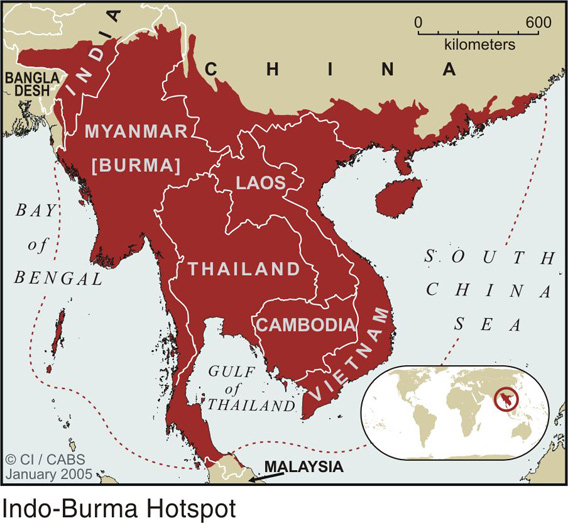
Map courtesy of CI.
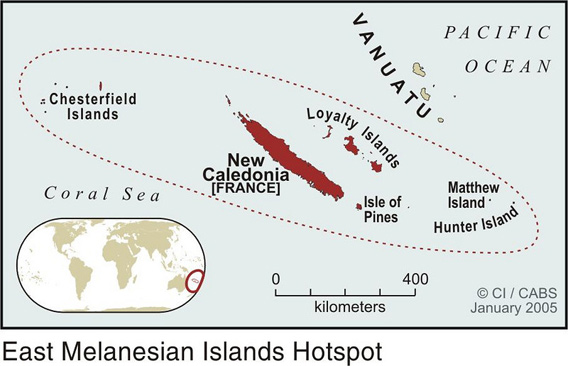
Map courtesy of CI.
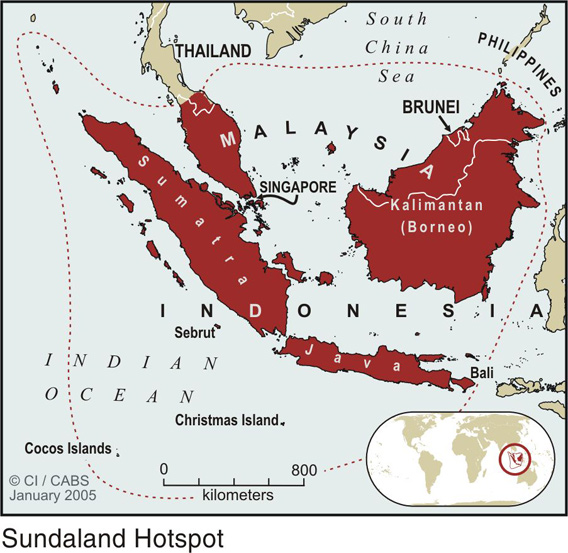
Map courtesy of CI.
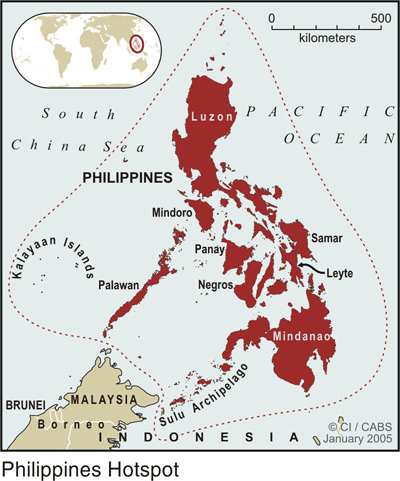
Map courtesy of CI.
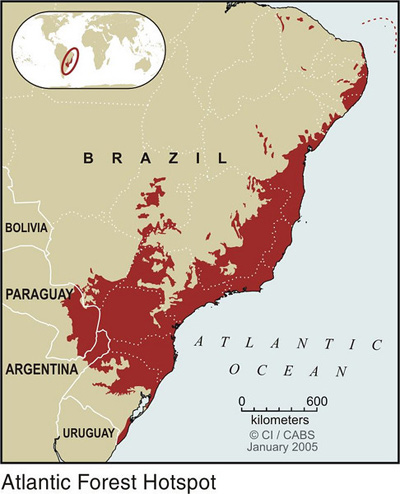
Map courtesy of CI.
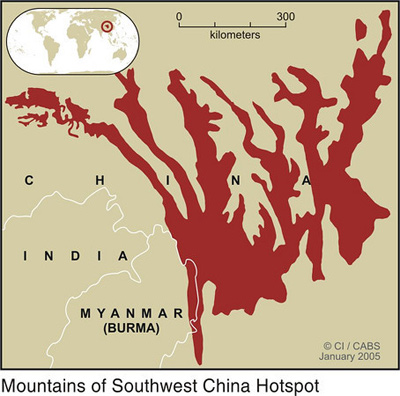
Map courtesy of CI.
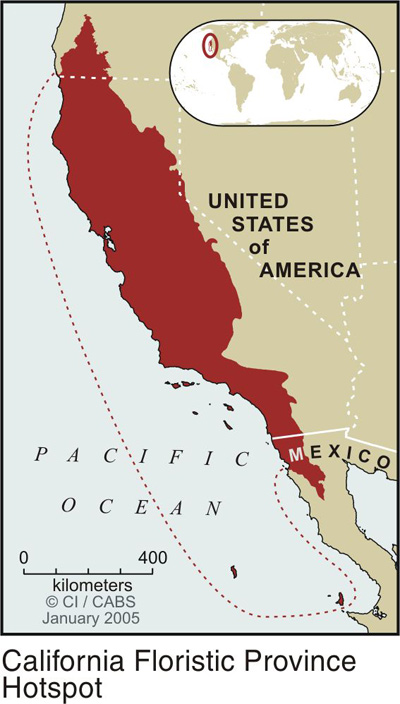
Map courtesy of CI.
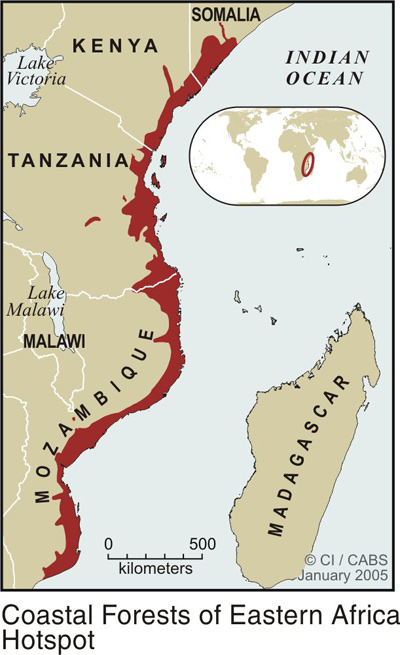
Map courtesy of CI.
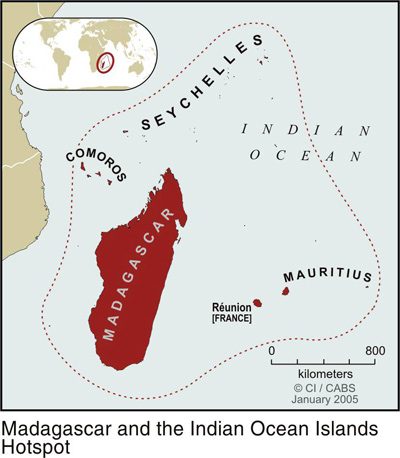
Map courtesy of CI.
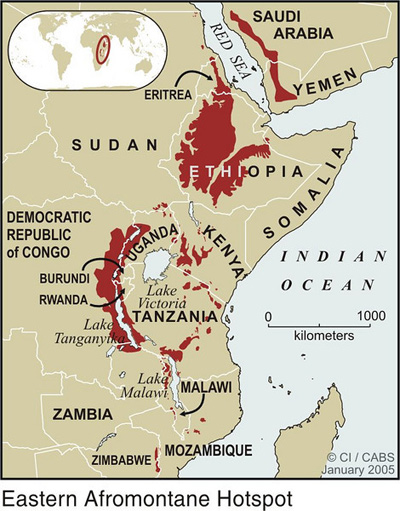
Map courtesy of CI.
Related articles
Malaysian palm oil producers destroying Borneo peat forests faster than ever before
(02/01/2011) Peatlands and rainforests in Malaysia’s Sarawak state on the island of Borneo are being rapidly destroyed for oil palm plantations, according to new studies by environmental group Wetlands International and remote sensing institute Sarvision. The analysis shows that more than one third (353,000 hectares or 872,000 acres) of Sarawak’s peatswamp forests and ten percent of the state’s rainforests were cleared between 2005 and 2010. About 65 percent of the area was converted for oil palm, which is replacing logging as timber stocks have been exhausted by unsustainable harvesting practices.
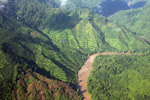
Greening the world with palm oil?
(01/26/2011) The commercial shows a typical office setting. A worker sits drearily at a desk, shredding papers and watching minutes tick by on the clock. When his break comes, he takes out a Nestle KitKat bar. As he tears into the package, the viewer, but not the office worker, notices something is amiss—what should be chocolate has been replaced by the dark hairy finger of an orangutan. With the jarring crunch of teeth breaking through bone, the worker bites into the “bar.” Drops of blood fall on the keyboard and run down his face. His officemates stare, horrified. The advertisement cuts to a solitary tree standing amid a deforested landscape. A chainsaw whines. The message: Palm oil—an ingredient in many Nestle products—is killing orangutans by destroying their habitat, the rainforests of Borneo and Sumatra.
Sustainable timber in Tanzania experiences huge growth
(01/18/2011) The level of Tanzanian timber forest certified as sustainable increased by 700 percent earlier this month. The certification not only represents an environmental win, but is expected to bring opportunities and money to the communities which exist within and around the forests.

Does chopping down rainforests for pulp and paper help alleviate poverty in Indonesia?
(01/13/2011) Over the past several years, Asia Pulp & Paper has engaged in a marketing campaign to represent its operations in Sumatra as socially and environmentally sustainable. APP and its agents maintain that industrial pulp and paper production — as practiced in Sumatra — does not result in deforestation, is carbon neutral, helps protect wildlife, and alleviates poverty. While a series of analyses and reports have shown most of these assertions to be false, the final claim has largely not been contested. But is conversion of lowland rainforests for pulp and paper really in Indonesia’s best economic interest?
Burning up biodiversity: forest fires increase in Madagascar
(01/10/2011) The number of fires burning in and around forests in the northeastern part of Madagascar increased during the 2010 burning season relative the the year before, according to analysis of NASA data by WildMadagascar.org / Mongabay.com. The rise in burning corresponds to an especially dry year and continued illegal logging of the region’s biologically-rich rainforests.
Good stewards of forests at home outsource deforestation abroad
(11/24/2010) As more nations adopt better laws and policies to save and restore forests at home, they may, in fact, be outsourcing deforestation to other parts of the world, according to a new study in the Proceedings of the National Academy of Sciences (PNAS). Looking at six developing nations where forests are recovering—instead of receding—the study found only one of them did not outsource deforestation to meet local demand for wood-products and food, a process known as ‘leakage’.
Tropical agriculture “double-whammy”: high emissions, low yields

(11/02/2010) Food produced in the tropics comes with high carbon emissions and low crop yields, according to a new study in the Proceedings of the National Academy of Sciences (PNAS). In the most comprehensive and detailed study to date looking at carbon emissions versus crop yields, researchers found that food produced in the tropics releases almost double the amount of carbon while producing half the yield as food produced in temperate region
Humanity consuming the Earth: by 2030 we’ll need two planets

(10/13/2010) Too many people consuming too much is depleting the world’s natural resources faster than they are replenished, imperiling not only the world’s species but risking the well-being of human societies, according to a new massive study by the World Wildlife Fund (WWF), entitled the Living Planet Report. The report finds that humanity is currently consuming the equivalent of 1.5 planet Earths every year for its activities. This overconsumption has caused biodiversity—in this case, representative populations of vertebrate animals—to fall by 30 percent worldwide since 1970. The situation is more dire in tropical regions where terrestrial species’ populations have fallen by 60 percent and freshwater species by 70 percent.
Losing nature’s medicine cabinet

(10/04/2010) In all the discussions of saving the world’s biodiversity from extinction, one point is often and surprisingly forgotten: the importance of the world’s species in providing humankind with a multitude of life-saving medicines so far, as well as the certainty that more vital medications are out there if only we save the unheralded animals and plants that contain cures unknown. Already, species have provided humankind everything from quinine to aspirin, from morphine to numerous cancer and HIV-fighting drugs. “As the ethnobotanist Dr. Mark Plotkin commented, the history of medicine can be written in terms of its reliance on and utilization of natural products,” physician Christopher Herndon told mongabay.com. Herndon is co-author of a recent paper in the journal Biotropica, which calls for policy-makers and the public to recognize how biodiversity underpins not only ecosystems, but medicine.
Logging crisis pushes Madagascar’s forests on to UNESCO’s Danger List

(08/01/2010) UNESCO’s World Heritage committee has added Madagascar’s unique tropical forests to its Danger List of threatened ecosystems. The move comes following a drawn-out illegal logging crisis that has seen loggers and traders infiltrating the island-nation’s national parks for rosewood. Bushmeat hunting of lemurs and other rare species also accompanied the crisis.
Illegal logging declining worldwide, but still ‘major problem’

(07/15/2010) A new report by the Chatham House finds that illegal logging in tropical forest nation is primarily on the decline, providing evidence that new laws and international efforts on the issue are having a positive impact. According to the report, the total global production of illegal timber has fallen by 22 percent since 2002. Yet the report also finds that nations—both producers and consumers—have a long way to go before illegal logging is an issue of the past.
Amazon and Atlantic Forest under threat: politicians press to dilute Brazil’s forestry law

(07/01/2010) A group of Brazilian legislatures, known as the ‘ruralistas’, are working to change important aspects of the Brazil’s landmark 1965 forestry code, undermining forest protection in the Amazon and the Mata Atlantica (also known as the Atlantic Forest) and perhaps heralding a new era of booming deforestation. The ruralistas, linked to big agribusiness and landowners, are taking aim at the part of the forestry code that requires landowners in the Amazon to retain 80 percent of their land area as legal reserves, arguing that the law threatens agricultural development.